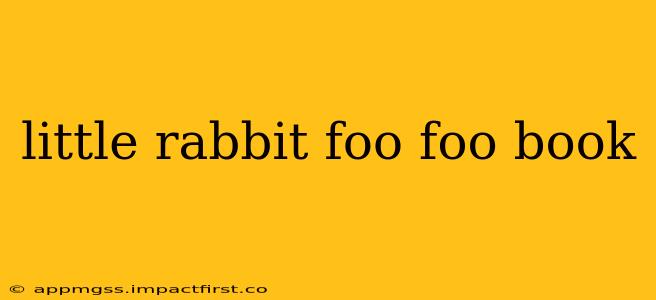Little Rabbit Foo Foo. The name alone conjures images of mischievous bunnies, grumpy old men, and a delightfully dark, repetitive rhythm that captivates children (and often adults!). This seemingly simple children's story, however, holds far more depth than its deceptively straightforward narrative suggests. This post will explore the story's enduring appeal, its various interpretations, and answer some frequently asked questions surrounding this classic tale.
What is the Story of Little Rabbit Foo Foo About?
The story centers around Little Rabbit Foo Foo, a mischievous bunny who enjoys committing various acts of playful cruelty—mostly targeting other animals. He kicks a field mouse, rolls a goose in the goo, and even whips a shy little snake. Each time, a gruff-voiced character, often referred to as the "Old Man," intervenes, rescuing the victims and ultimately sending Little Rabbit Foo Foo to the Good Fairy. The story ends with the Good Fairy magically transforming the bunny, often into something more benevolent or harmless.
The charm lies not only in the repetitive structure and the escalating acts of mischief but also in the satisfying resolution, albeit one that can spark discussion and varied interpretations. The seemingly harsh consequences of Foo Foo's actions serve as a gentle introduction to the concepts of cause and effect, responsibility, and even the possibility of redemption.
Who Wrote the Little Rabbit Foo Foo Story?
This is where things get a little murky. The origins of Little Rabbit Foo Foo remain shrouded in mystery. Unlike many well-known children's books, there's no single, definitively credited author. The story's popularity stems from oral tradition, with numerous variations and adaptations passed down through generations. This makes it a fascinating example of a folk tale, evolving and adapting to the whims and storytelling styles of those who share it. Because it's a story told and retold, pinning down a specific author is impossible.
What is the Moral of the Story of Little Rabbit Foo Foo?
The moral of the story isn't explicitly stated, allowing for a multiplicity of interpretations depending on the age and perspective of the listener. Some see it as a simple cautionary tale about the consequences of bad behavior. Others appreciate the inherent absurdity and the satisfying rhythm, focusing less on a moral and more on the sheer enjoyment of the narrative. Still others find a glimmer of hope in the Good Fairy's intervention, suggesting a possibility of forgiveness and transformation, even for the most mischievous characters. The lack of a definitive moral allows for rich discussions and fosters critical thinking in young audiences.
What are Different Versions of the Little Rabbit Foo Foo Story?
Variations abound! The specific actions of Little Rabbit Foo Foo, the animals he targets, and even the manner in which the Old Man intervenes can differ significantly. Some versions emphasize the bunny's wickedness more intensely, while others soften the tone. The variations highlight the story's adaptability and its ability to be personalized by each storyteller. This fluidity is a testament to its enduring appeal – the core structure remains engaging, regardless of the specific details.
Is the Story of Little Rabbit Foo Foo Scary?
The “scariness” of Little Rabbit Foo Foo is entirely subjective. For some young children, the repeated acts of mischief and the somewhat ambiguous ending might be slightly unsettling. However, the rhythmic nature of the storytelling and the ultimately positive resolution generally outweigh any potential fear. The playful tone and the satisfyingly repetitive structure often make the story more amusing than frightening. Parental guidance is always advised when introducing new stories to young children, allowing for discussion and clarification as needed.
Why is Little Rabbit Foo Foo So Popular?
Its enduring popularity stems from a confluence of factors: the engaging rhythm and repetitive structure, the satisfying resolution, and the ambiguous nature of the moral. The story’s adaptability allows it to be personalized and retold in countless ways, ensuring its continued relevance across generations. The inherent humor and subtle darkness create a unique appeal to both children and adults, solidifying its place as a modern classic. It's a story that invites participation, discussion, and creative interpretation—making it far more than just a simple bedtime tale.
